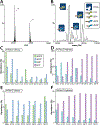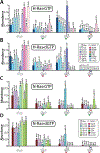2'-Deoxy Guanosine Nucleotides Alter the Biochemical Properties of Ras
- PMID: 37487239
- PMCID: PMC11131413
- DOI: 10.1021/acs.biochem.3c00258
2'-Deoxy Guanosine Nucleotides Alter the Biochemical Properties of Ras
Abstract
Ras proteins in the mitogen-activated protein kinase (MAPK) signaling pathway represent one of the most frequently mutated oncogenes in cancer. Ras binds guanosine nucleotides and cycles between active (GTP) and inactive (GDP) conformations to regulate the MAPK signaling pathway. Guanosine and other nucleotides exist in cells as either 2'-hydroxy or 2'-deoxy forms, and imbalances in the deoxyribonucleotide triphosphate pool have been associated with different diseases, such as diabetes, obesity, and cancer. However, the biochemical properties of Ras bound to dGNP are not well understood. Herein, we use native mass spectrometry to monitor the intrinsic GTPase activity of H-Ras and N-Ras oncogenic mutants, revealing that the rate of 2'-deoxy guanosine triphosphate (dGTP) hydrolysis differs compared to the hydroxylated form, in some cases by seven-fold. Moreover, K-Ras expressed from HEK293 cells exhibited a higher than anticipated abundance of dGNP, despite the low abundance of dGNP in cells. Additionally, the GTPase and dGTPase activity of K-RasG12C was found to be accelerated by 10.2- and 3.8-fold in the presence of small molecule covalent inhibitors, which may open opportunities for the development of Pan-Ras inhibitors. The molecular assemblies formed between H-Ras and N-Ras, including mutant forms, with the catalytic domain of SOS (SOScat) were also investigated. The results show that the different mutants of H-Ras and N-Ras not only engage SOScat differently, but these assemblies are also dependent on the form of guanosine triphosphate bound to Ras. These findings bring to the forefront a new perspective on the nucleotide-dependent biochemical properties of Ras that may have implications for the activation of the MAPK signaling pathway and Ras-driven cancers.
Conflict of interest statement
The authors declare no potential conflicts of interest
Disclosure of Potential Conflicts of Interests
No potential conflicts of interest were disclosed.
Figures





Similar articles
-
Capturing RAS oligomerization on a membrane.Proc Natl Acad Sci U S A. 2024 Aug 20;121(34):e2405986121. doi: 10.1073/pnas.2405986121. Epub 2024 Aug 15. Proc Natl Acad Sci U S A. 2024. PMID: 39145928 Free PMC article.
-
Intrinsic GTPase Activity of K-RAS Monitored by Native Mass Spectrometry.Biochemistry. 2019 Aug 6;58(31):3396-3405. doi: 10.1021/acs.biochem.9b00532. Epub 2019 Jul 22. Biochemistry. 2019. PMID: 31306575 Free PMC article.
-
Biophysical Characterization of RAS-SOS Complexes by Native Mass Spectrometry.Methods Mol Biol. 2024;2797:177-193. doi: 10.1007/978-1-0716-3822-4_13. Methods Mol Biol. 2024. PMID: 38570460
-
G proteins, effectors and GAPs: structure and mechanism.Curr Opin Struct Biol. 1997 Dec;7(6):849-56. doi: 10.1016/s0959-440x(97)80157-1. Curr Opin Struct Biol. 1997. PMID: 9434906 Review.
-
Three-dimensional structure of p21H-ras and its implications.Semin Cancer Biol. 1992 Aug;3(4):189-98. Semin Cancer Biol. 1992. PMID: 1421163 Review.
Cited by
-
Capturing RAS oligomerization on a membrane.Proc Natl Acad Sci U S A. 2024 Aug 20;121(34):e2405986121. doi: 10.1073/pnas.2405986121. Epub 2024 Aug 15. Proc Natl Acad Sci U S A. 2024. PMID: 39145928 Free PMC article.
-
Real time characterization of the MAPK pathway using native mass spectrometry.Commun Biol. 2025 Apr 16;8(1):617. doi: 10.1038/s42003-025-08028-5. Commun Biol. 2025. PMID: 40240517 Free PMC article.
-
Molecular glue degrader for tumor treatment.Front Oncol. 2024 Dec 12;14:1512666. doi: 10.3389/fonc.2024.1512666. eCollection 2024. Front Oncol. 2024. PMID: 39759140 Free PMC article. Review.
References
Publication types
MeSH terms
Substances
Grants and funding
LinkOut - more resources
Full Text Sources
Research Materials
Miscellaneous

